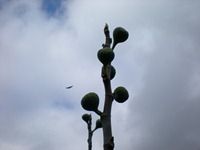Left Behind: A Story About 19 Lost Figs
Written by Nancy Diraison
 Fig trees are featured in many interesting ways in the Scriptures and can teach us more lessons as we study them. Here’s what I’m learning from my tree.
Fig trees are featured in many interesting ways in the Scriptures and can teach us more lessons as we study them. Here’s what I’m learning from my tree.
The first time fig trees are mentioned in the Bible we find them in Eden, with their leaves being used as mankind’s first covering. Since the leaves on some fig trees are 12 inches wide, they were a logical choice.
Figs are one of the oldest known cultivated trees. They are rich in nutritional content; and because of their lengthy growing and harvesting patterns, they are used as symbols of peace and prosperity (1 Kings 4:25; Micah 4:4; and Zechariah 3:10).
It seems figs were also used for their medicinal value, as exemplified in the poultice of figs used on King Hezekiah’s boils, though in that case God healed him miraculously (2 Kings 20:7). Figs are also mentioned symbolically in several New Testament parables.
Growing my own fig tree
I have always enjoyed figs, but it was only when I moved to East Texas that I could think of owning my own tree, due to their need for warmth.
I started my fig tree from a foot-tall shoot. For its first two winters, I nurtured it in a large pot on my deck, covering it on those few occasions when the temperatures dipped below freezing.
Eventually I planted the tree, and after the third year it shot up to 10 feet and started to produce. It didn’t produce a lot, just enough for me—three to six figs every day for many months.
More facts about figs trees
Even small fig trees provide wonderful, deep shade. The leaves on my variety are about seven inches broad, but the larger trees that reach 30 to 50 feet tall have a cooling effect on their surroundings and are sought after by wildlife. They are a blessing wherever they grow.
My tree’s figs are rock-hard and dark green until they are ready to pick, and they are almost invisible amidst the deep foliage. The figs suddenly become larger, softer, turn a light shade of green, and bend at the stem.
Figs don’t keep past two or three days and have to be picked immediately and consumed or processed promptly. They do not travel well unless dried, so it can be difficult to find them fresh in a store. Ripe ones must be picked for the next ones on the branches to mature.
The season ends abruptly
A cold snap hit in mid-November and my tree’s leaves turned brown and dropped to the ground within a day or two.
Perched atop the now scrawny, leafless branches were 19 figs that had failed to ripen in time. It made for a lonely picture—those “left behind” figs bobbing aimlessly against the gray autumn skies. Gone was the verdant cover that had nourished and shaded them from the blistering summer sun.
What about us?
Watching these figs has made me ponder the concept of spiritual readiness, because time does run out. The cold day comes and the opportunity to reach maturity is over.
One interesting aspect of figs is that they must mature on the tree. They will not ripen if picked when immature, and they are inedible if not ripe. So they only get one chance; and when it comes to figs, ready is ready.
The people of God are compared to growing things, so we, too, must consider. We know that in the parable of the true vine, Christ tells us we must abide in Him in order to grow (John 15:1-5).
And in Matthew 21 and Mark 11, we read how Jesus saw an inviting, leafy fig tree from afar, but finding it fruitless, He cursed it. The withered tree symbolized the danger of appearing productive but having no fruit.
When time is up
What might we conclude about a fig tree that drops its leaves and is left with “stillborn” fruit?
To me it seems the leaves could model the cover, protection and nourishment that the Church provides for the fruit.
Figs cannot ripen ahead of schedule, but the right conditions must be maintained for all the figs to reach maturity. Once the leaves are lost, the tree goes into dormancy and all development is ended.
So how important are the leaves? They must thrive so that all the fruit can mature, and so that none will be “left behind” like my 19 orphans.
The Church, in other words, needs to stay warm and healthy. Do I have an impact on that? What can I do to help?
I’m reminded of two scriptures.
- “And because lawlessness will abound, the love of many will grow cold” (Matthew 24:12).
- “I must work the works of Him who sent Me while it is day; the night is coming when no one can work” (John 9:4).
We need to stir up the Spirit of God to keep His love flowing through us. Lives depend on it.
For more about why God put Christians in the Church, see the section on “The Church” on the Life, Hope & Truth website.
Nancy Diraison is an East Texas member of the Church of God, a Worldwide Association. Writing everything from music to blogs is her favorite occupation!








